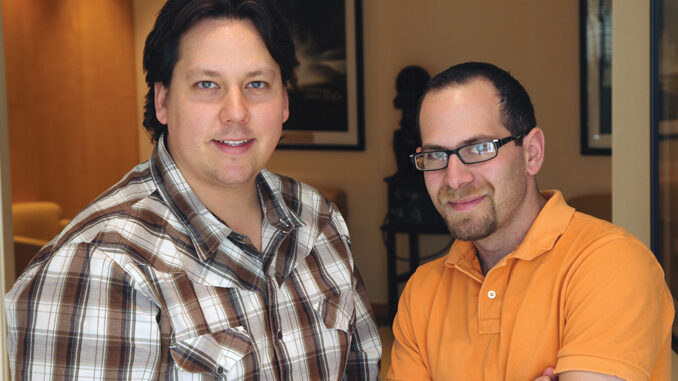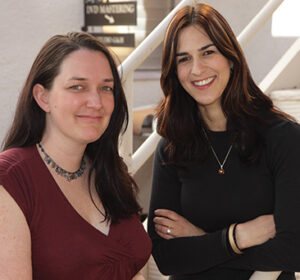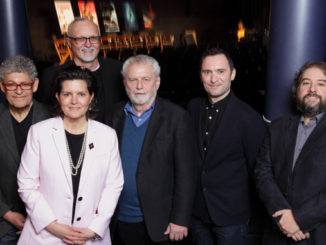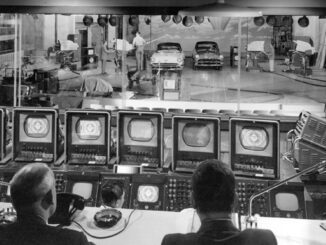
by Michael Kunkes
Michael Pedraza is a man with a plan. While attending film school in Arizona, he decided that he would work with one of his two favorite editors—Michael Kahn, A.C.E., or Dylan Tichenor, A.C.E. Happily, he had an “in” in that his editing teacher’s claim to fame was that he had worked in Kahn’s editing room on Saving Private Ryan.
Armed with that knowledge and sure it would win him a job, Pedraza went to Los Angeles, purchased a USC T-shirt and attended film classes there for over a year without enrolling. After a brief internship at Warner Bros., he landed a job as a production assistant for Marty Cohen, at that time head of post-production at DreamWorks SKG. Strategically locating his desk in the kitchen of DreamWorks’ post-production offices, he started meeting Kahn and others in his crew— assistants Pat Crane, Mike Cuevas, Mark Gillard, Michael Wilson, Michael Trent and Sam Seig––while they were working on The Terminal. “It took me nine months just to meet them,” he says. “They were kind of this secret group behind closed doors.”
Slightly nervous at the prospect of working in a film editing room, he bought and studied a copy of Norman Hollyn’s The Film Editing Room Handbook and worked as a PA on other features, including Anchorman: The Legend of Ron Burgundy, The Heartbreak Kid, The Ring Two and then two Kahn-edited films, War of the Worlds and Munich. Finally, Pedraza came into the Guild as an apprentice editor on Indiana Jones and the Kingdom of the Crystal Skull through the efforts of Cohen, Crane, current DreamWorks post-production supervisor Mark Graziano and Kahn himself. As it turns out, he never had to use his “in” from the teacher in Phoenix. Good thing, too. “I finally asked about him and it turned out to be a lie,” Pedraza reveals. “No one had ever heard of him.”
That’s a long parable, but it illustrates the kind of networking skills, dedication, improvisation and plain chutzpah it takes to become an apprentice editor–– known as an edit room assistant (ERA) on the East Coast––perhaps the most highly prized entry-level position in post-production, and the one from which its owner wants to be promoted as soon as possible. Not because it’s a bad job; quite the opposite. Whether they want to be an editor or a career assistant, the path starts here––sometimes by design and some- times serendipity.
All that Zackhary Schwartz knew was that he wanted to break into film. He started as an art department PA on Season Two of HBO’s The Wire, which was shooting in his native Baltimore. He moved to New York, worked at a post accounting firm, and held down PA jobs on various features, including 2007’s Stop-Loss, where he first met editor Claire Simpson. She hired him on Stephen Daldry’s The Reader, the film which finally landed him in the Guild as an ERA, in no small part due to the efforts of Simpson, who made a personal appeal to The Weinstein Company.
“I’ve always wanted to be a writer, but once I saw how much of a film’s story is shaped in the editing room, I knew I wanted that to be my career,” Schwartz recalls. “I don’t know if that would have happened without Claire’s help. She’s cut a lot of my favorite films—Platoon, Wall Street, The Constant Gardener—and during The Reader, she made me a part of the process with all the assistants and was always very open and generous with her knowledge. As with any profession, the passing of knowledge is key to the longevity of the field; finding that mentor who will go to bat for you is very important.”

Back in LA, Emily Koonse started work on Disney’s Race to Witch Mountain––a big-budget, supernatural thriller edited by David Rennie, A.C.E., for a March release––as an apprentice. What’s unusual is that Koonse has been an assistant editor for nearly two years, working on independent features. Before joining the Guild, she was an editor, post supervisor and Final Cut Pro instructor. With all that background, she took the apprentice position on Race, she explains, because an apprenticeship is one of the major portals into the edit room on a studio feature, a fact which under scores both the budgetary restrictions of indies and TV shows that keep editorial crews small (sometimes just an editor and one or two assistants), as well as the high regard in which the apprentice is held in the fully staffed studio editing room.
Koonse’s past technical experience served her well, and she was promoted to assistant halfway through production. “With a full crew, there is more of a break- down of responsibilities and everything is more orchestrated,” she says. “The benefit for me and for the production is that I am able to step in and do more if need be. I was green, but not too green, and I had a lot to learn about how a big feature editing room is supposed to work. A good apprentice always must be willing to stand up and say, ‘Yes, I can do that.’”
As with Koonse, Amy McGrath’s path to apprenticeship involved a lot of prior experience, added to some networking and a bit of luck of the Irish. Trained as a painter, she entered the post world via operations and project management at two New York facilities, producing dailies and online edits and working on her own projects at night. In part thanks to the efforts of editor David Kirchner, she was able to enter the Guild and was hired as an ERA for Steven Soderbergh’s The Girlfriend Experience. Her duties on that project point out the changing shape of the job.
“The Girlfriend Experience was shot on the Red camera,” explains McGrath, “So my job involved helping assistant editor Jason Barnes transcode the Red files through Red Rushes software, create and import ALEs (Avid log exchange), back up to LTO (linear tape-open) tapes and organize camera and sound reports.”
McGrath’s current duties at Jonathan Demme’s Harlem-based facility where she works on his upcoming documentary about Bob Marley (working title Marley, edited by Carol Littleton, A.C.E., and Martin Levenstein), are more typical of the digital editing room—organizing camera and sound reports, creating continuity documents, making scene cards for the editors, maintaining a Filemaker Pro database of logged tapes and quality controlling tapes. And because Marley is a documentary, she also keeps tabs on a massive amount of media. “The way I learn is by doing,” McGrath says. “I have a good grasp on the theory; it’s a question of understanding which buttons to press.”
LA-based Jill Piwowar represents apprentice editors on the Guild’s Board of Directors, having held apprentice positions on S.W.A.T., Mr. and Mrs. Smith, My Super Ex-Girlfriend and I Think I Love My Wife before graduating late last year to the position of assistant editor on Nick and Norah’sInfinitePlaylist,edited by Myron L. Kerstein.
“I had been working as a PA on American Outlaws, which was being edited by Michael Tronick, A.C.E., and his great crew,” she says. “They took me under their wing, taught me everything I needed to know and were able to get me into the Guild during re-shoots on The Scorpion King.”
Events happened relatively quickly for Nolan Reese, who is the son of Philadelphia Eagles broadcaster Merrill Reese. Reese came to Los Angeles as part of a BostonUniversityFilmSchool satellite program and began as an intern and, later, assistant editor on the American Cinema Editors (ACE) documentary, The Cutting Edge: The Magic of Film Editing. He then held PA positions on the WB series Charmed and Summerland.
Reese worked on Richard Schickel’s documentary Bienvenue a Cannes and David Dobkins’ Fred Clause, and soon after joined the Guild, hired by John Ottman to work as an apprentice on 2008’s Valkyrie. Working with assistants Andrew Loschin and Dylan Firshein, Reese continued his visual effects turnover chores, along with a host of new tasks. “I learned how to set up and organize an Avid project, maintain backup procedures, convert Avid DNx36 outputs into a variety of formats, handle scan orders and maintain and keep track of a Filemaker Pro database,” Reese explains. “Also, because I had handled film very little, Andrew, who was the visual effects editor, was great at showing me how digital related back to the way things used to be done in film––in terms of feet and frames, what a tail pop is and how you actually make a cut. Like a lot of people raised on digital, I learned to cut by moving a mouse everywhere. It wasn’t until I got in that I realized how much I didn’t know. Now, I feel ready to take that next step.”
To editors reared entirely in the digital age, Pedraza’s duties as a film apprentice may sound at best only vaguely familiar. He fires up the KEM, cleans the sound heads and turns on the dubber and coding machines. He then picks up dailies and sound transfers from the lab, imports data from the lab reports into the code book and then uses that data to make trim tabs and trim boxes with scene, take and code number information. “And that takes me up to lunch,” he says. “Then I rewind film and reconstitute trims. I also make sure that there are enough cores, change the blades on the splicers, and ensure that Michael Kahn has his editor’s glove. These are all classic apprentice duties that you won’t see in a digital cutting room.” He does share one duty with almost every other apprentice: “I’m usually the first in and the last to leave.”

“It takes a certain kind of personality to be an apprentice,” adds McGrath. “You must be mature and an independent thinker––and have a willingness to learn and take direction. It’s an extremely important position that should be promoted in the industry, because it provides mentoring for young people who are serious about developing a career in editing.”
Apprentices get the bulk of their training and mentoring from assistant editors, and Schwartz is quick to credit Jens Baylis and Carrie Puchkoff, first and second assistants, respectively, on The Reader. “Jens is a great balance of easygoing with an extremely deep knowledge of not only editing, but film as a medium,” he relates. “Carrie is extremely organized and great at creating easy-to-read distilled documents. I learned from her how to make the editing room flow better and how to be proactive about learning the job; mainly I learned that being an apprentice is about being alert and on the ball all the time––a good skill to have in any profession. Working on a film can be very stressful and intense, but it can also be relaxed and fun––but never so much that you can let your guard down. It’s important in those moments of duress to be able to step up and know more than the job necessarily requires.”
Piwowar feels that a good apprentice is, in turn, highly prized by assistant editors. “Assistants have a lot of tasks that weigh them down, and it’s just too much to expect them to do everything,” she says. “The entry-level nature of the apprentice position gives them the opportunity to teach someone their way of doing things. With crews getting smaller along with budgets, a good apprentice is a win- win situation for a production.” Piwowar adds that, “For me, the ideal crew would be an editor, first assistant, second assistant, an apprentice and possibly a PA. You need that one person who can coordinate dailies with the executives, enter data in codebooks and sort through camera reports. We need more, not fewer, apprentices.”
Pedraza offers some passionate advice for would-be apprentices. “It’s important to show the people who you work for that you have the passion to move up, so take every opportunity you can to work with experienced editors. When you’re looking to get in, sometimes networking and knowledge can be as good as pay. Learning the editing room involves a certain amount of being a sponge––of ‘stealing with your eyes,’ as someone once said. Right now, I am exactly where I want to be—in the world of the editing room, getting paid and being in the union.”
Piwowar sums up what every apprentice’s goal should be, no matter what career path they ultimately choose. “For myself, I’d love to edit, but I was the best apprentice I could be and I intend to be the best assistant I can be before I move up. Why be in this great position and not understand everything about what you do? It’s a lot to learn, but it’s worth learning well.”






